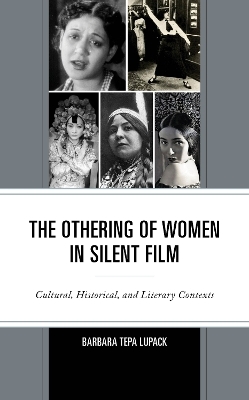
The Othering of Women in Silent Film
Cultural, Historical, and Literary Contexts
Seiten
2023
Lexington Books/Fortress Academic (Verlag)
978-1-6669-1396-5 (ISBN)
Lexington Books/Fortress Academic (Verlag)
978-1-6669-1396-5 (ISBN)
In The Othering of Women in Silent Film: Cultural, Historical, and Literary Contexts, Barbara Tepa Lupack explores the rampant racial and gender stereotyping in early cinema and demonstrates how that imagery helped shape American attitudes and practices.
In The Othering of Women in Silent Film: Cultural, Historical, and Literary Contexts, Barbara Tepa Lupack explores the rampant racial and gender stereotyping depicted in early cinema, demonstrating how those stereotypes helped shape American attitudes and practices. Using social, cultural, literary, and cinema history as a focus, this book offers insights into issues of Othering, including discrimination, exclusion, and sexism, that are as timely today as they were a century ago. Lupack not only examines the ways that dominant cinema of the era imprinted indelible and pejorative images of women—including African Americans, Native Americans, Asians, Hispanics, and New Women/Suffragists—but also reveals the ways in which a number of pioneering early filmmakers and performers attempted to counter those depictions by challenging the imagery, interrogating the stereotypes, and re-politicizing the familiar narratives. Scholars of film, gender, history, and race studies will find this book of particular interest.
In The Othering of Women in Silent Film: Cultural, Historical, and Literary Contexts, Barbara Tepa Lupack explores the rampant racial and gender stereotyping depicted in early cinema, demonstrating how those stereotypes helped shape American attitudes and practices. Using social, cultural, literary, and cinema history as a focus, this book offers insights into issues of Othering, including discrimination, exclusion, and sexism, that are as timely today as they were a century ago. Lupack not only examines the ways that dominant cinema of the era imprinted indelible and pejorative images of women—including African Americans, Native Americans, Asians, Hispanics, and New Women/Suffragists—but also reveals the ways in which a number of pioneering early filmmakers and performers attempted to counter those depictions by challenging the imagery, interrogating the stereotypes, and re-politicizing the familiar narratives. Scholars of film, gender, history, and race studies will find this book of particular interest.
Barbara Tepa Lupack is former professor of English at St. John’s University and academic dean at SUNY.
Acknowledgments
List of Illustrations
Note on Terminology and Usage
Introduction
Chapter 1: African Americans
Chapter 2: African Americans: Race Films
Chapter 3: Native Americans
Chapter 4: Native Americans: Native Responses
Chapter 5: Latins
Chapter 6: Asians
Chapter 7: The New Woman
Chapter 8: Suffragists
Conclusion
Bibliography
About the Author
| Erscheinungsdatum | 28.10.2023 |
|---|---|
| Sprache | englisch |
| Maße | 160 x 237 mm |
| Gewicht | 680 g |
| Themenwelt | Kunst / Musik / Theater ► Film / TV |
| Sozialwissenschaften ► Kommunikation / Medien ► Medienwissenschaft | |
| Sozialwissenschaften ► Soziologie ► Gender Studies | |
| ISBN-10 | 1-6669-1396-0 / 1666913960 |
| ISBN-13 | 978-1-6669-1396-5 / 9781666913965 |
| Zustand | Neuware |
| Informationen gemäß Produktsicherheitsverordnung (GPSR) | |
| Haben Sie eine Frage zum Produkt? |
Mehr entdecken
aus dem Bereich
aus dem Bereich
wie KI und virtuelle Welten von uns Besitz ergreifen – und die …
Buch | Hardcover (2023)
Heyne (Verlag)
22,00 €
meine virtuelle Kamera (K.I.)
Buch (2024)
Spector Books OHG (Verlag)
26,00 €


